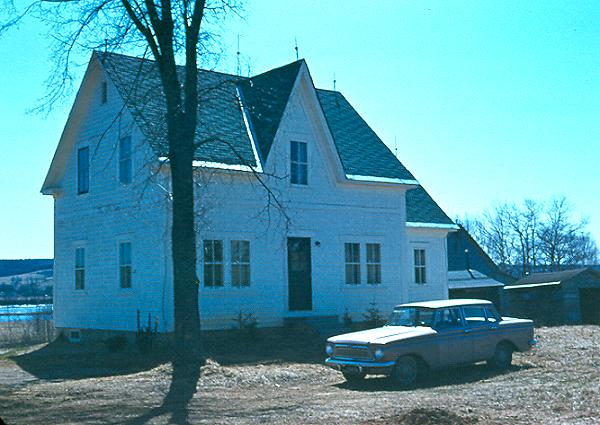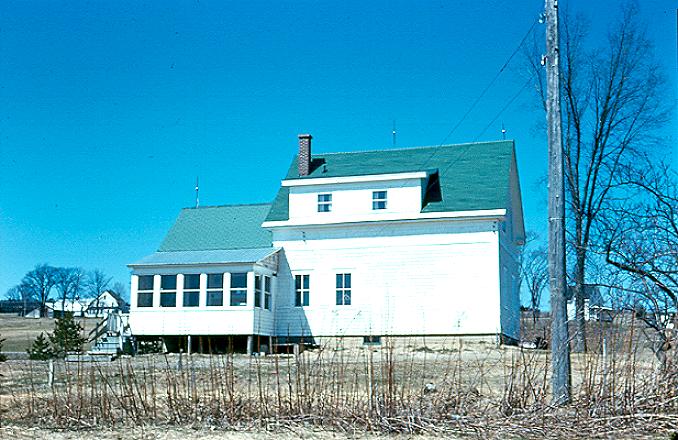Chapter Fifteen, Fredericton I, 1964
In the last chapter I recounted the birth of my third daughter, Dana. Within weeks of her birth in March, we moved to Fredericton as I had been appointed the Assistant Manager of the Zellers situated there. With this chapter, I intend to cover off the balance of 1964 when we were at Fredericton. We continued to be at Fredericton for all of 1965, though the last of it we will deal with in the next chapter.
As for what was going on in the world: On February 25th Muhammad Ali beat Sonny Liston in Miami Beach and was crowned the heavyweight champion of the world. That March, the first Ford Mustang rolled off the assembly line at Ford Motor Company. At the Republican National Convention in San Francisco, held in July, the U.S. presidential nominee Barry Goldwater declared that "extremism in the defense of liberty is no vice", and "moderation in the pursuit of justice is no virtue." This was the same month when six days of race riots broke out in Harlem. So too, the unmanned American spaceship, that July, Ranger 7 sent back the first close-up photographs of the moon. It was a presidential election year in the U.S.; incumbent U.S. President Johnson defeated Republican challenger Barry Goldwater with over 60 percent of the popular vote. In December, comedian Lenny Bruce was sentenced to 4 months in prison after a 6-month obscenity trial. In South Africa that year, political activist Nelson Mandela began his life sentence. The Catholic Church condemned the oral contraceptive pill. The soldier doll G.I. Joe was brought to the market.
The IBM System/360, a mainframe computer system was brought out by IBM on April 7, 1964; it was a system that IBM sold straight through to 1978. It was the first family of computers designed to cover the complete range of applications, from small to large, both commercial and scientific. "The design made a clear distinction between architecture and implementation, allowing IBM to release a suite of compatible designs at different prices. All but the most expensive systems used microcode to implement the instruction set, which featured 8-bit byte addressing and binary, decimal and floating-point calculations." That May, two code writers ran the first program written in BASIC (Beginners' All-purpose Symbolic Instruction Code). When I bought my first home computer (TRS-80) in 1980, I learned BASIC and worked with it for a number of years; in time, we will come to my experiences with my first computer.
In March of 1964, as already mentioned, I and my little family settled into a fourth Maritime community -- Halifax, 1961; Truro, 1962; and Bathurst, 1963. I do not know to what extent I looked around Fredericton for rental accommodations, but I became sold on a farmhouse on the banks of the Saint John River above the main community of Fredericton, at Douglas (circled in red to the right). We enjoyed our stay on the farm. It consisted of only a farmhouse and a garage (locked for the use of the landlord). The area for the garden had long been worked as such, and with the help of Mr Waugh, the farmer just across the road, I had the field plowed and a garden planted that first spring. The field right next to our place (owned by Waugh) had that year the most marvelous field of corn, tall with great waxy, green leaves. We made plans to take a few ears when the fall came. I think Mr Waugh knew we might be interested in doing such a thing. On one of our frequent visits to his operation, while in the barn with lines of cows lined up and waiting to be milked, he told me that if I was interested in corn in the coming fall he had some to give me and that the field next to me was used for fodder, the corn while looking large, yellow and healthy, would be very tough to eat.
While on the subject of eating things that we found on our little farm, I need but mention the apple orchard (which Mr Waugh would come down and spray for us) and the fiddle heads (sprouting ostrich ferns) found in great numbers in the spring along the river's edge. The river, the Saint John River, was to be seen fully from our backyard. It was white and fully frozen in the winter, at least the surface of it was. In March, maybe the first of April, one would wake up in the morning and see the surface broken up, considerably raised, with junks of ice flowing along with the spring flood all of it going down stream hasting to its appointment to meet the ocean, many miles away. I am not sure of the time of the year they fished, but certain of the locals had a license to net salmon, which then, and not in great numbers, were making their way up the river. I befriended one of these fellows, another neighbour, and I was soon watching him working his net. He did it, if I recall correctly, from one of the grassy and elongated islands which were common along this stretch of the Saint John. The net stretched from the shore to the anchored end out in the river, fifty feet, or so. There was a bell on the net and this man knew when there was something tangled in his net and would waste no time to row along the net to isolate and pull his catch into his small boat. The reason he had to get out there in a hurry, was because there were ells, all about, who were only too happy to swim right down the throat of the large salmon and start in to eating it. He never left the land end of his net, day or night; likely his licence allowed for only a couple of days of fishing. I remember spending a night on the island with this fisherman. We never got very much sleep, as we were obliged to immediately answer the call of the bell. One time, what we found, was a sturgeon, a large reptilian looking thing with large scales (actually bony plates called scutes). I was surprised as I thought one would have to go to Russia to find them; not so, I was told there was no lack of this North American variety in the Saint John. Our fisherman had no desire to keep a sturgeon; he was only after the very marketable salmon which swam up the Saint John, large and bright.
The Saint John River floods annually, however, it posed no problem to where we lived, as the farmhouse was high up the eastern bank of the river. Fredericton, itself, however, was often threatened by the flood waters as the lower streets in the downtown area were next to the river. The Zellers store I worked in was downtown and relatively close to the river; it would be in danger of being flooded, not the main floor, but the basement. There was usually a running prediction by the authorities as to how high the river was going to be during the few days of the annual spring flood. The stock room was in the basement, so we kept the stock up on the higher shelves when there was a chance of flooding. I recall a line with the inches marked off on one of the concrete basement walls; the inches being related to the spring water levels. I do not remember experiencing a flood in the store's basement in the years that I was there.
The Zellers store at Fredericton was a very different store than those that I had worked in up to that time. I knew of the store through the numbers. Except for a couple of stores in Ontario, Fredericton enjoyed a very large and profitable volume; it was, for sure, the highest volume store in the Maritimes, and every one knew that my next move in a year or two was going to be to my own store. As we will see in the next chapter, a year after I arrived a major expansion took place. I was very impressed with the operation when I arrived in March of 1964. As I did at Bathurst, I would have to initial each order which the department heads made up and passed in. I would randomly pull orders and go to the counter and review the order with the department head. (Incidentally, even after all these years, I can still recite the number and name of each of the 26 departments that existed at the time: Candy, no. 1; Notions no. 2, Hosiery, no. 3, and so on.) I remember, shortly after I arrived, going to the hosiery girl in Fredericton with an order which she had written for a hundred dozen of no.2 women's nylons -- a hundred dozen. I had just come from a store that would go through a couple of dozen in the run of week. The lady, an old hand in the store (it had an exceptional staff) said that was a regular order and needed to maintain one of the front ends just as one entered the store. I realized that I was on a new learning curve and this experienced staff was going to be of great assistance to me. The store itself had "old fashion" store hours honoured by all of the large retailers in Fredericton, of which, likely then, Zellers was the largest. Friday nights only, to 9:00 o'clock; Saturdays to noon. Those hours, I would never see again in my retail career. Yet the store did a huge volume. During Friday nights and Saturday mornings the isles of the store were crowded with eager shoppers.
In 1964, Merv Griffin's game show Jeopardy! was first shown; Art Fleming was its first host. Bewitched, starring Elizabeth Montgomery, premiered on TV. Stanley Kubrick released Dr. Strangelove. Walt Disney's Mary Poppins had its premiere. It went on to become Disney's biggest moneymaker, and winner of 5 Academy Awards, including a Best Actress award for Julie Andrews, who accepted the part after she was passed over by Jack L. Warner for the leading role of Eliza Dolittle in the film version of My Fair Lady. Mary Poppins is the first Disney film to be nominated for Best Picture. The James Bond series continued to come into the theatres, in 1964 it was From Russia with Love.
As for music: On February 9th, The Beatles appeared on The Ed Sullivan Show, marking their first live performance on American television. Seen by an estimated 73 million viewers, their appearance became the catalyst for the mid-1960s "British Invasion" of American popular music. Incidentally, as of April 4th, The Beatles held the top 5 positions in Billboard's top 40 singles in America. Not to be outdone, and it seems never will they be for longevity, The Rolling Stones released their debut album, The Rolling Stones. So what were the songs of 1964, that I remember: Ferry Cross The Mersey by Gerry & The Pacemakers, Wishin' And Hopin' by Dusty Springfield, You're My World by Cilla Black, and, of course, Oh, Pretty Woman by Roy Orbison.


